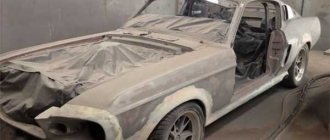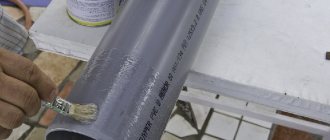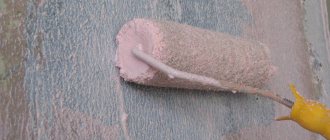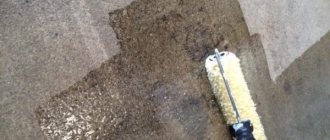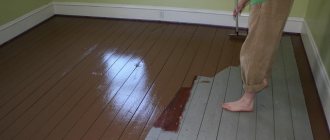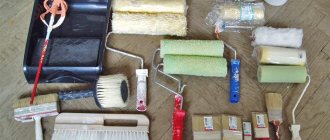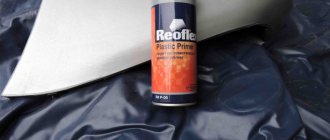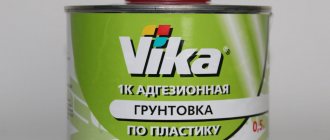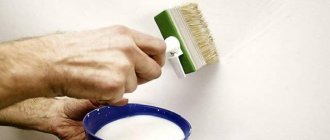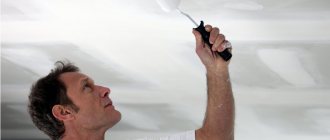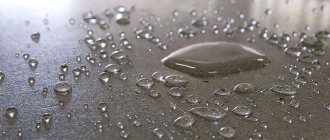Every person has encountered repairs at least once in their life. It often seems that painting walls, tiling or wallpapering is a simple matter. But for a high-quality finish and overall aesthetics, it is necessary to use a primer, which is applied as a base layer to the surface. It forms good adhesion to the top layers of the coating, thanks to its ability to penetrate deeply into pores and fill them. The use of this material ensures a long service life of the surface.
What is the difference between impregnation and primer?
The store has a huge variety of wall treatment products.
What is the difference between impregnation and primer? In this regard, I have the opinion that there is no particular difference between these materials. This is a simple play on words. Some manufacturers call the same material impregnation, others call it primer, approving the corresponding technical conditions for production.
But in terms of their properties and purpose, both impregnations and primers differ:
Basically, these materials are made on the basis of acrylic and the lighter the color of the impregnation, the smaller the particles of the binder and the deeper they penetrate into the surface being treated.
What is the difference between impregnation and primer?
Impregnation is created in order to saturate the surface before further processing to protect it from various influences: moisture, fungal diseases, mold and other options for strengthening walls and their structure.
There are primers that perform the function of both impregnation and priming (protection and adhesion), but there are no impregnations that perform the function of increasing the adhesiveness of walls.
The primer is not always an impregnation: primer for metal, quartz primer, insulating primer, reactive primer, void-filling primer, etc.
Maybe when the impregnation is a primer: a universal penetrating primer, alkyd tinting antiseptics for wood, weak solutions of film-forming agents for priming absorbent substrates.
Source
Antifungal
Mold fungus is one of the main problems faced by homeowners.
If mold is found on the walls, it can be removed. But mold often hides in layers of thermal insulation. Mold can destroy the surface and harm the health of the inhabitants of this house.
To avoid unwanted consequences, it is better to purchase an antifungal primer that will help in pest control. It is used as a prophylactic agent when decorating premises in conditions of high humidity.
The price depends on the composition, so when choosing, you need to carefully study it. It is made on the basis of various components, but more often the basis is fungicides, which help destroy harmful organisms and prevent their occurrence. Before applying the composition, the base must be cleaned and thoroughly dried. Antifungal, like others, is applied using a roller or brush with natural bristles.
Careful protection and precautions are also required during use. In case of contact with skin, the affected area should be rinsed with clean water.
What is the difference between primer and impregnation?
Primer for concrete is an anti-corrosion, universal and durable material. As a rule, it is used to prepare various surfaces for coating using different enamels. Primers are used for external and internal work. This material is also used during renovation work for floors, facades, ceilings and walls. Undoubtedly, the use of a primer makes it possible to achieve a high-strength connection between the surface that will be painted and varnish or paint. The primer can protect the painted surface from peeling. Today, primers are divided into adhesive and strengthening. They are sold both in finished form and as dry mixtures that require the addition of organic solvents or water.
Primer for concrete floors is applied to the surface in different ways, for example:
By the way, sometimes the package will indicate the recommended tool for each specific composition. Each layer of soil can dry completely in about a day.
The difference between primer and impregnation is that the latter can significantly improve the quality of the concrete mixture. Impregnations also play a significant role in protecting the concrete surface from water and other negative influences. Perhaps it is due to impregnation that the constructed building can last for many years.
How to choose a primer, types and differences of primers
Let's talk about the classification of primers, their types and the specifics of each type of primer.
A primer is the basis for applying any decorative coating. Without primer, the paint will begin to peel, crack, or bubble sooner. Essentially, this is preparing the surface for applying paint, putty, etc. The primer is used in the form of a liquid homogeneous mass, which consists of fillers and special components in a binder polymer.
The fact is that different materials have different porosity and tendency to absorb moisture. And the primer “equalizes” the properties of all surfaces, while adhering tightly to them.
How to choose a primer
Primers today are made on a wide variety of bases. The type of primer is selected based on the type of surface being treated, the conditions in which the primer will be located (humidity, temperature), and the planned decorative coating.
For example, before wallpapering, a concrete wall must be primed with glue; it will fill the pores in the concrete. Otherwise, the glue will be absorbed into the concrete (its ability to absorb moisture is very high), and the layer of glue directly under the wallpaper will be scanty.
At the same time, the number of special priming compositions in construction stores is impressive, and they differ primarily in the type of binder included in their composition:
Acrylic
As with acrylic paints, they can be used on almost all types of surfaces, such as brick, plaster, cement, concrete, wood, fiberboard and chipboard. Acrylic primers do not smell, dry in a couple of hours, that is, they do not slow down the finishing process. Not recommended for processing ferrous metals, because do not prevent the formation of rust.
Alkyd
Primarily suitable for wood processing. This type of primer swells the surface in a special way, allowing any finishing coating to adhere well to it.
The drying time of alkyd primers is slightly longer - up to 15 hours. Alkyd primers can be made using both zinc phosphate (this primer serves as an excellent anti-corrosion coating for alkyd paints), and zinc chromate - also reliable protection against corrosion, but suitable for various types of paints.
Glypthal
Glypthal primers are suitable for use in dry rooms. Dries completely within a day. They have proven themselves best in metal processing.
Perchlorovinyl
Like glyphthalic, they are excellent for priming metals. You can treat plastered brick and concrete surfaces. Used for outdoor work. In the warm season, they dry in 1 hour.
Polyvinyl acetate
Polyvinyl acetate primers are intended as a base for polyvinyl acetate paint and dry in 30 minutes.
Polystyrene
Suitable for plastered and wooden surfaces. They contain toxic solvents, so use is allowed only in ventilated areas.
Phenolic
Phenolic primers can be used on wood and metal. It takes up to 12 hours to dry.
Purpose and properties of impregnations
All types of impregnations are divided into two groups:
If the impregnation is based on polyurethane or acrylic, then these impregnations are classified as organic. They are able to remove excess dust from the concrete mixture. It is for this reason that the mixture acquires a high level of strength. In the future, the erected structure will have high resistance to adverse environmental conditions. Inorganic impregnation for concrete floors consists of fluates, which are also capable of providing a high level of strength. However, inorganic-based impregnations have another significant advantage - protection from chemical influences. All types of impregnations can be applied to concrete that has not yet dried, which only adds convenience during construction work. So, one of the main features of impregnation is that the entire layer of concrete will be impregnated, and the service life of the structure will be significantly increased.
Source
Protective impregnation for wood
Wood is protected from the risk of deformation and damage by preservation. For this purpose, wood impregnations are used. The compositions protect against moisture, rapid combustion, and biological factors. Impregnating primers are used during the construction process, finishing and repair work.
- Types of wood impregnations
- By purpose
- Depending on the base
- Impregnation colors
- Criterias of choice
- For interior work
- For outdoor use
- Popular manufacturers
- Recommendations for use
- Making wood impregnation with your own hands
What is the difference between impregnation and primer?
The store has a huge variety of wall treatment products. What is the difference between impregnation and primer?
In this regard, I have the opinion that there is no particular difference between these materials. This is a simple play on words. Some manufacturers call the same material impregnation, others call it primer, approving the corresponding technical conditions for production.
But in terms of their properties and purpose, both impregnations and primers differ:
- strengthening impregnations to strengthen the top layer of the treated surface with the formation of a visible film;
Basically, these materials are made on the basis of acrylic and the lighter the color of the impregnation, the smaller the particles of the binder and the deeper they penetrate into the surface being treated.
What is the difference between impregnation and primer?
Impregnation is created in order to saturate the surface before further processing to protect it from various influences: moisture, fungal diseases, mold and other options for strengthening walls and their structure.
A primer can also be protective, but its main purpose is to level the surface of the walls and increase adhesiveness (adhesion).
There are primers that perform the function of both impregnation and priming (protection and adhesion), but there are no impregnations that perform the function of increasing the adhesiveness of walls.
Primer - in the broad sense, it can have not only an impregnating effect, but also a filling (in the form of a coating), adhesive (with quartz sand), insulating and many others. The primer can be a liquid solution of paint or glue. There are a hundred options, and all of this is ground. “Impregnation” - it is clear that this is a kind of substance that does not create a coating.
The impregnation is not always a primer - for example, hard-to-wash out preservatives for wood, fire-fighting impregnations, silicone impregnations for stone, oil- and petrol-resistant impregnations for concrete, etc.
The primer is not always an impregnation: primer for metal, quartz primer, insulating primer, reactive primer, void-filling primer, etc.
Maybe when the impregnation is a primer: a universal penetrating primer, alkyd tinting antiseptics for wood, weak solutions of film-forming agents for priming absorbent substrates.
How to choose a primer
Primers today are made on a wide variety of bases. The type of primer is selected based on the type of surface being treated, the conditions in which the primer will be located (humidity, temperature), and the planned decorative coating.
For example, before wallpapering, a concrete wall must be primed with glue; it will fill the pores in the concrete. Otherwise, the glue will be absorbed into the concrete (its ability to absorb moisture is very high), and the layer of glue directly under the wallpaper will be scanty.
At the same time, the number of special priming compositions in construction stores is impressive, and they differ primarily in the type of binder included in their composition:
Acrylic
As with acrylic paints, they can be used on almost all types of surfaces, such as brick, plaster, cement, concrete, wood, fiberboard and chipboard. Acrylic primers do not smell, dry in a couple of hours, that is, they do not slow down the finishing process. Not recommended for processing ferrous metals, because do not prevent the formation of rust.
Alkyd
Primarily suitable for wood processing. This type of primer swells the surface in a special way, allowing any finishing coating to adhere well to it.
The drying time of alkyd primers is slightly longer - up to 15 hours. Alkyd primers can be made using both zinc phosphate (this primer serves as an excellent anti-corrosion coating for alkyd paints), and zinc chromate - also reliable protection against corrosion, but suitable for various types of paints.
Glypthal
Glypthal primers are suitable for use in dry rooms. Dries completely within a day. They have proven themselves best in metal processing.
Perchlorovinyl
Like glyphthalic, they are excellent for priming metals. You can treat plastered brick and concrete surfaces. Used for outdoor work. In the warm season, they dry in 1 hour.
Polyvinyl acetate
Polyvinyl acetate primers are intended as a base for polyvinyl acetate paint and dry in 30 minutes.
Polystyrene
Suitable for plastered and wooden surfaces. They contain toxic solvents, so use is allowed only in ventilated areas.
Phenolic
Phenolic primers can be used on wood and metal. It takes up to 12 hours to dry.
Review of deep-penetrating impregnations for concrete
To protect structures from mechanical stress and moisture, deep penetration concrete impregnations are used. Unlike conventional primers, they penetrate deeper into the structure of the material, strengthening its surface. The base becomes stronger and more resistant to wear.
Strengthening agents are used for all types of concrete, including very dense ones, since they do not have pores into which the finishing could penetrate and take hold. The impregnation has an even smaller size, so it is able to penetrate into the products, thereby creating a glossy film, on which another coating can subsequently be applied.
Types and characteristics
Available with different parameters and purposes. If it is necessary to increase the wear resistance of a floor with a screed, it is recommended to choose a product that can penetrate as deeply as possible. If you are treating a vertical base, for example a wall, then it is enough to buy a primer that forms only a film, since water will still not be able to hold out.
There are several types of impregnations - strengthening and waterproofing. When choosing the first type, you need to carefully study the composition. Such options, in order to improve the strength of a floor or other structure, change its structure at the molecular level using chemical additives. These include fluorescent (Elacor MB-1), calcium-binding fluorosilicates, and lithium (C2 Hard). They penetrate deeply into the concrete surface, forming insoluble calcium hydroxide. As a result, it becomes resistant to wear, moisture, chemicals and does not emit dust. They can be applied to old substrates. No grinding or polishing is required after processing.
Water-based silicate polymers (Ashford Formula) operate on almost the same principle. After penetrating into concrete, their particles react with cement stone. As a result, new formations with increased hardness appear. Silicate impregnations are often used for car parks, walkways and other heavily loaded areas. Chemicals are applied once during the entire period of operation, after which no additional treatments are required.
Waterproofing types are used to protect against moisture. They penetrate very deeply into the structure of materials, thereby creating a dense, moisture-proof film. This not only helps protect the surface from water, but also increases the frost resistance of the structure. Moisture cannot penetrate inside, and as a result, the likelihood of concrete destruction due to its expansion during freezing is eliminated.
Water and wear impregnations differ in composition:
Inorganic are means that change the structure of concrete at the molecular level, that is, chemical. They not only protect against water, but also improve all technical characteristics of the structure, including the strength grade. All hardening impregnations belong to the inorganic class.
Organic are polyurethane, epoxy and acrylic compounds. The principle of operation is that they fill free pores, thereby preventing water from penetrating inside. In addition to all this, they bind the surface of the base, preventing the appearance of dust and making it more resistant to wear and chemicals.
Polyurethane, compared to other types, is able to penetrate 2 or even 3 times deeper - up to 1 cm. The upper part of the plane is converted into a new material - concrete polymer, which has the following characteristics:
To achieve the required results, you need to dilute the product with a solvent according to the specified proportions. Most often it is either 1:2 or 1:3. If you violate the ratio, the coating will only protect against water, like a regular primer.
Application technique and recommendations
Before processing concrete, it is carefully prepared. If the base is old, then all topcoats are removed. Chips and potholes are covered with mortar and leveled. Once the plaster has dried, the structure is sanded. The same applies to new grounds. Dirt and grease stains are cleaned off, after which everything is sanded. Such preparation will allow you to penetrate deeper into the structure and better strengthen it, as well as increase the degree of adhesion with finishing materials.
To finish surfaces with deep penetration agents, brushes, rollers or special equipment are used. The method of application must be indicated on the impregnation container. For example, so that the Ceresit ST17 primer can penetrate as deeply as possible, it is applied with a brush or roller. If the surface being treated is cellular concrete, then for the first layer the liquid is diluted with water in a ratio of 1:1, the second is made undiluted and painted with it only after the previous one has completely dried.
Primers should only be used for their intended purpose. If it is made for indoor use, it is not suitable for outdoor use. Under the influence of precipitation and other natural influences, it will quickly lose its properties. Likewise, impregnations are not recommended for exterior use inside buildings. They may contain substances that, when evaporated, release compounds hazardous to human health.
Particular attention should be paid to the ambient temperature. Many compounds cannot be applied if the temperature is negative or below +5°C. Subsequent finishing with the topcoat can be started only after the primer has completely dried.
Prices depend on the manufacturer’s brand, container volume and characteristics. The deeper the composition is able to penetrate and strengthen the structure, the higher its price will be. The greatest demand is for impregnations that protect against moisture penetration, such brands as Knauf, Ceresit, Starateli, Elakor, Betonkontakt.
For concrete and other mineral bases from Ceresit, CT17 and CT17 Concentrate are used, both water-dispersed. For ease of application, CT17 has a yellow tint, but if a transparent impregnation is needed, then you should choose the second one, since it is colorless. Ceresit CT 17 does not reduce the vapor permeability of the base, but it does not allow moisture to penetrate inside. The cost of a five-liter canister of Ceresit ST17 starts from 350 rubles. Fluating and strengthening options have a higher price. Elakor MB-1 Fluat costs 205 rubles per 1 kg, Protexil - from 200 per liter.
Before purchasing, you need to check the expiration date, compatibility with other materials and purpose. If the base will be painted, then select a primer that matches the composition of the paint. If dry spots appear after treatment, they are re-coated. Excess liquid that has not yet dried can be removed with a cloth and water; the dried primer can be removed with a solvent.
Other types of primers
Different types of this finishing material differ from each other in the way they affect the applied surface. They are usually applied under some kind of coating, such as putty, paint or varnish.
Acrylic
Penetrates deep into the surface, reducing the consumption of applied paint or putty.
It is usually odorless and dries fairly quickly. It is made on the basis of acrylic copolymers, usually applied to various substrates: wood, concrete, plaster, brick. Acrylic primer can be strengthening or deep. Its connecting elements are 10 times larger than those of the deep one, so it has the property of surface gluing. It is necessary to pay attention to the consistency, which should be similar to milk.
Alkyd
This primer mixture can be used to treat wooden and metal surfaces. It is better to use alkyd for treating wood indoors. There are also particularly durable types of alkyd primer that can be used for glass or tiles. This material is not suitable for plaster or drywall, since after applying the composition the surface turns out to be uneven.
Shellac
Typically, this type is used for processing wood, and in its raw form. It is not very popular among builders because it is a relatively new type of finishing material. This primer mixture is more suitable for application to a wooden surface made from softwood. It neutralizes the effects of resin that is present in the wood and prevents its discoloration.
Epoxy
Known as a paint and varnish material for application to metal surfaces to prevent their corrosion. Resistant to mechanical and temperature influences. In addition, it protects the metal from exposure to the sun and moisture, and prevents paint from peeling off the metal. After drying, it creates a smooth surface, helping subsequent coatings to lay down perfectly. However, this type requires quite a long time to dry.
Strengthening primer Volma-Universal (10l)
The primer is intended for the preparation of highly absorbent substrates for plastering, painting, puttying, wallpapering, ceramic tile cladding and self-leveling floors/foam-aerated concrete, gypsum plasterboard, plasterboard, plasters, brick, cement screeds, etc. Primer properties: Increases the adhesion strength of finishing materials to basis. Reduces the consumption of paint compositions. Strengthens weak foundations. The primer has an antiseptic effect. Unlike PVA-based primers, it has a high degree of water resistance and vapor permeability. Ready for use and does not require dilution. Preparation of the base: The base must be dry, free of dust, oils, and other substances that reduce the adhesion of the primer to the base. The surface temperature when applying the primer should be from +5 0C to +30 0C. Application of the primer: Apply with a brush, roller or spray at a temperature from +5 0C to +30 0C in one layer. Further work with the surface is carried out after the primer has completely dried. Tools should be washed with water immediately after working with the primer. For application on durable, non-porous substrates, dilution with water 1:1 is possible. Technical characteristics: base: styrene-acrylate dispersion consumption: 100-200 ml/m2 primer color: white film color: transparent drying time: up to 1 hour shelf life: 12 months storage temperature: from +5 0C to +30 0C number of freezing/thawing cycles during storage: no more than 5
The primer is intended for the preparation of highly absorbent substrates for plastering, painting, puttying, wallpapering, ceramic tile cladding and self-leveling floors/foam-aerated concrete, gypsum plasterboard, plasterboard, plasters, brick, cement screeds, etc. Primer properties: Increases the adhesion strength of finishing materials to basis. Reduces the consumption of paint compositions. Strengthens weak foundations. The primer has an antiseptic effect. Unlike PVA-based primers, it has a high degree of water resistance and vapor permeability. Ready for use and does not require dilution. Preparation of the base: The base must be dry, free of dust, oils, and other substances that reduce the adhesion of the primer to the base. The surface temperature when applying the primer should be from +5 0C to +30 0C. Application of the primer: Apply with a brush, roller or spray at a temperature from +5 0C to +30 0C in one layer. Further work with the surface is carried out after the primer has completely dried. Tools should be washed with water immediately after working with the primer. For application on durable, non-porous substrates, dilution with water 1:1 is possible. Technical characteristics: base: styrene-acrylate dispersion consumption: 100-200 ml/m2 primer color: white film color: transparent drying time: up to 1 hour shelf life: 12 months storage temperature: from +5 0C to +30 0C number of freezing/thawing cycles during storage: no more than 5
Universal
When additional elements are added to a deep penetration primer, the latter acquires universal properties. This type of material is suitable for processing both vertical and horizontal surfaces, regardless of the type of finish. It is used for internal and external repair and finishing work.
Universal primer is usually available in the form of a ready-made mixture that does not need to be diluted with water, unlike concentrates. It already contains water, as well as acrylic latex, antiseptics, synthetic additives and biocides. Dries quickly, smoothes out uneven surfaces on walls and prevents complete penetration into porous surfaces.
When using primers of this type, you must take precautions and work exclusively with gloves and protective clothing. After completing the finishing work, the room must be thoroughly ventilated. After use, the remaining material is stored in a tightly closed container away from children.
How to choose a product for wood? Impregnations, glazes, stains, oils - what is what, and why
This article is the best instruction for those who want to “paint” something wooden, but are not at all versed in paint materials. Or he is well versed in impregnations and antiseptics, but sometimes does not know how to correctly answer particularly meticulous “literates”. How do you generally understand how good a product is for wood? We told you what the manufacturers are silent about.
At least once in their life, everyone will be faced with the need to buy floor varnish, repaint shelves or countertops, or update the appearance of a wooden door. If with ordinary paints and varnishes everything is more or less clear, then it is very difficult to navigate all the antiseptics, primers and impregnations, and even from different manufacturers.
First, let's understand the terms.
What are impregnation and stain, what are oil and glaze?
Impregnation is any product that is used to impregnate wood to improve and preserve its properties. This can be called anything: from an antiseptic designed to protect the tree from biological damage, to a substance that gives color - after all, all these compounds impregnate the tree.
A stain is a substance that is used to treat wood to change its color or impart certain decorative, protective or priming characteristics. At the same time, substances that perform only one of the listed functions are often called stain.
That is, these concepts are somewhat blurred, the words impregnation and stain can be synonymous, but sometimes they are fundamentally different materials. The situation is simpler with the terms azure and oil.
Azure is a decorative transparent product that colors and emphasizes the structure of wood and protects it from harmful influences. Azure coatings can be different: for example, in the line of the manufacturer Belinka there are 4 azures for different needs and areas of application: Lasur and Toplasur, Interier and Exterier.
Wood oil is simply a natural (read: safe) oil, sometimes with a mineral additive, that is used to protect the wood without altering its natural appearance. Oils are indispensable for hard-to-cut hardwoods such as oak, teak, larch.
The best way to figure out which wood product you need
And now you need to process some kind of wooden surface. It’s easy to get confused in the offers, because different manufacturers often offer completely different compositions under the same name.
A simple rule will help you choose a product for wood: think about exactly what qualities you need to give to your specific wooden product or structure. If your wood product (or set of products) does not provide any function, it is a bad product.
What is a good product for outdoor wood?
What is important for a structure that will stand in the open air? Let's say it's a wooden bench, a gazebo, the facade of a house or a fence. To make a tree last a long time outdoors, you need:
Which wood product is best to use in the house?
What qualities are important for preserving the wood of an interior door, a piece of furniture or lining that covers the kitchen walls? We need:
Conclusion: choose a product for wood based on its functions, not on its name.
How to choose an effective set of materials for wood: secrets that manufacturers are silent about
But there is another problem: most often, one remedy is not enough: it is almost impossible to contain solutions to all problems in one jar. Often a combination of primer plus stain, or tinting agent plus varnish is required. How to choose this complex so that the products complement each other, and each of them is truly effective? Again, think about what properties you want to give to the wood, and based on this, choose each material carefully.
What a primer for wood should be: 4 main parameters
A primer for wood should first of all be an antiseptic primer. That is, perform 2 main functions.
1. As a primer, it should guarantee adhesion (good adhesion) of the finishing layers to the base so that they hold tighter and their service life will increase, and it should also equalize the absorbency of the base, thanks to which you will save on the consumption of finishing materials and get a uniform color of the surface; 2. As an antiseptic, the primer should, penetrating deeply into the wood, protect the tree from the development of a) fungi and b) insect pests (this function is important only for wet rooms or outdoors; in a dry room you can completely do without an antiseptic).
In addition, an antiseptic primer for wood should:
3. be indelible - otherwise it will instantly be useless on the street and in damp rooms, it will simply be washed off; 4. be non-evaporating - otherwise it will not only quickly lose its properties, but will pose a threat to your health as soon as you use it somewhere indoors.
Moreover, a high-quality primer must meet all four of these parameters. It's sad that half of the brands on the market don't pass this simple test.
7 signs of high-quality glaze (impregnation)
Azure coatings are applied to wood for protection, as well as to give it a certain color or shade. It is important to consider the following.
What should a quality wood oil look like?
When choosing wood oils, you should pay attention to the following points.
Should oil give color to wood? Technically, this is possible, but to do this, you need to add other components to it that reduce the important properties of the oil; as a result, such a substance can no longer be called oil, it is more like an impregnation.
Important: if you want to add color to wood, it would be better to use not oil, but colored azures or, for example, tinted varnishes. After all, oil impregnation was invented as the most natural, non-altering way to treat wood.
Now you have ready-made lists of important qualities that you should ask the seller about before purchasing wood product. Use them and no one will be able to sell you useless material anymore. Be careful and patient!
Well, if you still have a question about which product to choose specifically for your case, you can get the answer for free here.
How to choose a primer: types, consumption and characteristics
For any responsible action, quality preparation is important. Not so long ago, no one was priming walls, for example, before wallpapering. As a result, yellow spots from the glue appear, and surface unevenness is emphasized even more. Air gets into the cracks in the base and the wallpaper also begins to crack. This is precisely why painstaking finishing of the room is so important. Your main assistant in this is the primer.
The primer changes the properties of the surface, preparing it for painting, whitewashing, plastering or wallpapering. It is used to treat all surfaces of the room, even before laying tiles or floor screed. It mainly serves to improve adhesion and make the surface more durable. They produce soil mixtures for filling microcracks, removing dust, pollution, and also for increasing or decreasing porosity. There are protective options that protect against corrosion and rotting or with antifungal and antibacterial effects.
When choosing a primer, you should consider the base on which it will lie and the coating that will be applied to the primed surface.
The main difference between primers presented on the building materials market is the presence of universal components in their composition. The latter allows you to achieve the best effect in each specific case.
Types of primer according to purpose
- Impregnating mixtures are designed to prevent fragile plaster from falling off. They are used for treating drywall before laying tiles or for impregnating the base under wallpaper. The hydrophobic effect helps protect the surface from excess moisture.
- Antiseptic compounds will improve adhesion and prevent mold and bacteria from settling in your home.
- Anti-corrosion materials protect the metal. Special “rust destroyers” help in the fight against rusty deposits that have already appeared.
- Wood primers are used to treat wooden surfaces before painting or varnishing. They are able to protect the tree from parasites and atmospheric influences.
Reasons for using primers
Transparent primer for wood floors
Is a wood primer really necessary for varnish or is it still possible to do without using these products and thus save money?
It turns out that there are a number of objective reasons for using priming agents, among which we note:
- Ensuring better adhesion of the surface of lumber and paint coatings. Regardless of the type of surfaces being painted, paints and varnishes adhere much better to special primers. As a result, having previously prepared the surface, you can be sure that the paint will not peel off or bubble over time due to non-compliance with the operating temperature.
- Saving paint and varnish materials, since the price of primers is an order of magnitude lower than the cost of paints and varnishes.
In the photo, drying oil is a traditional solution for treating wood before painting.
Wood has a porous structure that actively absorbs applied paints and varnishes. By applying a primer, we close the pores, after which you can paint in one layer.
- High quality of painting, since the use of primers guarantees a leveling effect.
Special coating recommended for decoupage practice
The surface of lumber, even after mechanical processing, is not perfectly smooth. Primer compounds, when applied to the surface, fill small irregularities, as a result of which the prepared lumber looks more even and the paint adheres to it more evenly.
- Strengthening effect due to the penetration of primer compounds into the pores of wood. Penetrating into the porous structure, these solutions harden, as a result of which the porous structure of the wood ceases to be such and becomes almost monolithic to a depth of 1 cm from the surface.
So, we have decided that a primer for wood is necessary for exterior work and for interior finishing work. It remains to find out what products for preparing painted surfaces can be purchased in specialized stores.
Classification of primer coatings
Acrylic primer for decoupage on wood
In order to find out which primer is best for wood, you need to decide what requirements you place on these products and the surface they treat. The fact is that different primer compositions have different properties. Therefore, in order to choose a suitable product, we will consider the range presented on the market and tell you about the properties of this or that variety.
Primer is a wide range of compounds prepared using a natural or synthetic base. These products necessarily contain liquid or solid film-forming substances, such as, for example, wood drying oil, alkyd, formaldehyde and epoxy resins, urea, etc.
The range of primers is presented in colorless or colored varieties. Painted modifications are usually purchased for subsequent application of paints and varnishes, while colorless analogues are applied to the surface before applying varnish.
Depending on the composition and characteristics of the filler, the primer is applied in a layer whose thickness ranges from 0.01 to 0.1 mm (10-100 microns).
Doors ready for painting
According to their composition, primers are divided into the following categories:
- Shellac primers are designed to neutralize the effects of resins. The use of such products is especially justified when working with coniferous wood, where there are a large number of resin pockets.
Moisture-proof treatment of wooden lining
Decorative impregnation for wood
Any wood product without proper processing loses its original appearance over the coming months. Houses and garden buildings must be protected immediately after construction with special impregnations. Most water-based acrylic-based compounds require updating every 3-5 years. The new generation of primer-impregnations for wood from the Galamix brand protects wood longer - up to 10 years, and glaze impregnations give the surface shades of noble wood species.
Why are impregnations needed?
Wood impregnation performs a protective and decorative function: it protects wood from external influences, preserving its natural beauty, and gives it a certain tone, emphasizing the texture of the wood. Decorative properties are especially important for interior decoration; the protective properties of impregnations come to the fore when treating external surfaces (houses, country houses). Primer impregnation for wood creates a protective layer on the surface that strengthens its structure and protects the material from a wide range of external influences:
- from UV rays;
- from other atmospheric influences and humidity;
- from insect pests of wood;
- from damage by fungus and mold.
Application area
Decorative wood impregnations are intended for finishing and protecting all types of wood. These compounds are used for treating houses and other buildings made of timber, boards, lining, etc. Impregnation treatments require wooden fences, garden buildings, house facades, including those finished with imitation timber and block houses.
Indoors, primer-impregnation is used to treat platbands, baseboards, stairs, frames, window sills, and furniture.
Decorative impregnations for wood Galamix
Primer-impregnation for wood from the Russian manufacturer Galamix is today the optimal choice for manufacturers of wooden houses and other wood products, for builders and finishers. Impregnation GALAMIX-57 allows you to reliably protect wood and increases its service life: if the application technology is followed, the coating retains its protective properties for up to 10 years.
Primer impregnation for wood Galamix – water-dispersion, acrylic based. The composition can be colorless or tinted according to the GALAMIX catalog and according to the customer’s sample.
Wood impregnation does not contain toxic substances, therefore it is a universal and safe composition, suitable for both external and internal work. When applied to wood, the primer-impregnation reveals its texture and forms a silky coating with a noble shine.
How to prepare a surface for impregnation
The service life of any protective and decorative composition largely depends on the quality of surface preparation. It includes:
- thorough cleaning of dust and dirt, stains and drips;
- removal of old paints and varnishes (scraper, metal brush, hair dryer);
- sanding wood. It is recommended to pay special attention to this stage, since it is this stage that guarantees good adhesion of the impregnation to the surface, that is, the durability of the treatment and the preservation of the wood.
Surface preparation must be carried out in several stages: the wood is sanded before applying the coating and after each layer has dried. Remember that sanding should be carried out along the grain of the wood. When carrying out preliminary grinding, you need to start with sandpaper with a grain size of 200 - 250 microns (P 80) in order to even out the marks of the cutting tool. Then abrasive material with a finer grit of 80-100 microns (P150) should be used. Carry out a thorough cleaning of dust.
Which application method to use
You can apply wood impregnation in any convenient way:
- By dipping. Impregnation is a deep penetration material. With this method of application, a coating with maximum protective properties and color intensity is formed in one layer.
- Pouring - on specialized machines and varnish-filling machines.
- Paint sprayers are the most convenient tool for treating large areas, such as wooden houses. Impregnation applied using a sprayer forms a perfectly smooth, uniform film on the surface of the wood - this coating is considered the highest quality. When choosing between a pneumatic and airless spray gun, we recommend choosing a pneumatic one: it provides higher quality painting.
- Paint rollers. Quite convenient to use: the roller allows you to cover a large area with the composition in one movement, which saves time and effort.
- With brushes. It is more convenient to paint large surfaces with wide brushes - from 100 mm.
How to calculate impregnation consumption
An important property of Galamix wood impregnations is low consumption, which reduces the cost of processing products. Consumption is 100-120 g/m2. To calculate the amount of material required, multiply this figure by the surface area you need to treat.
Take into account technological losses: about 10% of the material must be allocated for them.
The consumption of wood impregnation also depends on the method of its application: a brush uses the solution more economically; when using a spray gun, certain losses due to spraying are always generated (an additional 5-10%).
How to apply wood stain correctly
1. Before application, the wood impregnation must be thoroughly mixed.
2. It is recommended to treat surfaces at air temperatures not lower than +18 °C and not higher than +28 °C. In this case, the temperature of the composition itself must be at least 15 °C.
3. The surface of the wood must be dry. It is not recommended to apply impregnation after rain: you must wait until the wood is completely dry.
4. Recommended number of layers: 2-3. Drying time between coats: 1-2 hours. Complete drying of the coating occurs 20-24 hours after applying the finishing layer.
Generalization on the topic
Each of the described impregnations has a narrow scope of application. Using them helps prepare the surface for subsequent processing. Priming rules are indicated on the packaging. The brief instructions tell you at what temperatures the treatment can be carried out and what level of humidity should be present.
It is necessary to treat the concrete floor until the composition stops being absorbed into the surface. You can use a regular roller to apply the material. And the primer consumption is indicated on the packaging.
Author:
